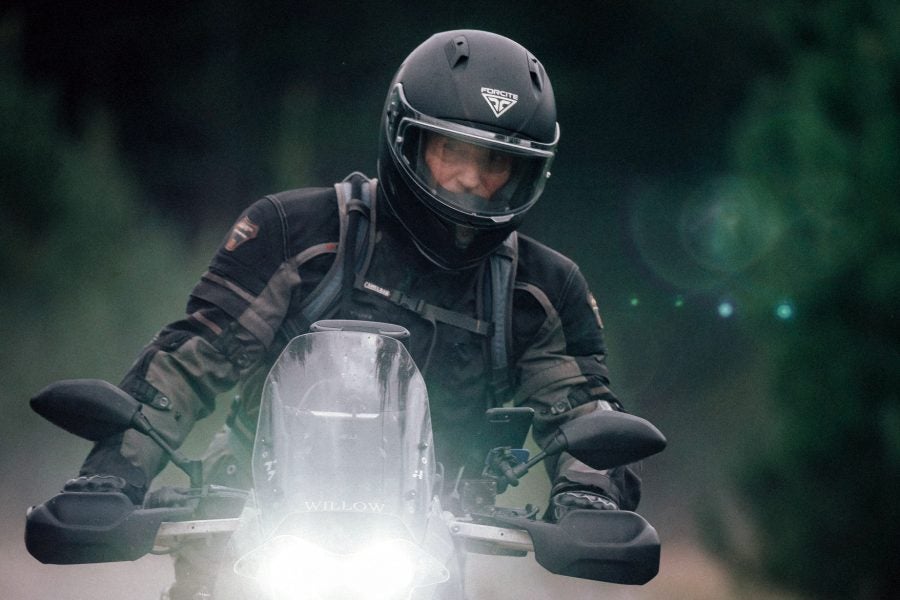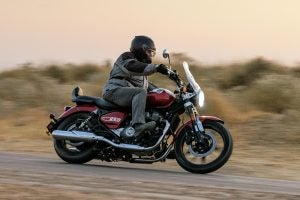Update: Forcite helmets were not available in the US market during this review, but they are now. Forcite sent ADVrider.com a new Euro-spec MK1S model for review. Key difference: EU helmets have a built-in sunshade, U.S. helmets do not.
The quest for a “smart” motorcycle helmet has been a decade-long and often agonizing trip down a rock and pothole-strewn road of good intentions, hype, technical roadblocks, safety debates, a detour of alleged financial malfeasance (SKULLY) and ultimately, a junkyard of failed or orphaned products (NUVIZ).
But the appeal of such high-tech headgear seems to be real: The 2013 Skully Indiegogo campaign raised over $2.4 million USD on the promise of a stylish, self-contained computerized helmet that recognized voice commands, included comms, and promised a near sci-fi level perk: an in-helmet head-up display (or HUD) that included GPS TBT visual prompts and a live video feed from a rear-facing wide-angle camera.
Thousands of riders ponied up four figures to get in line for one, but years (and lawsuits) later, only a tiny number ever received anything, even after the project was revived as the Skully Fenix AR in 2017 by a well-meaning consortium, Skully Technologies, with links to GasGas and other entities with actual money.
I was able to try on and preview a working pre-production model of the “new” Skully Fenix AR helmet at CES in 2018. It was… underwhelming, especially when compared to what had been promised, but at least they were giving it a go and promised to do right by the original backers. But that effort failed as well, and the few mythical Skully lids that were actually produced pop up on eBay now and again, typically at a discount from their original $1,500 price tag.
Enter Forcite

The Forcite system is made up of the helmet, handlebar controller and the smartphone app. Image: Forcite
A more recent—and notably more successful—effort to give smart helmets a go is Australia-based Forcite. Forcite claims it has shipped thousands of their high-tech helmets and recently sent me the latest model, the MK1S, for review, even though it is not yet available in the US—but it will be soon. I’ve been using it for several months now, including taking it to India for the Royal Enfield Super Meteor 650 press ride.
Previous to receiving the Forcite MK1S, my history with “smart helmets” was long. As a poor college kid, I DIYed a comms system into my helmets decades ago. I also reported on the Skully helmet campaign and implosion beginning back in 2013, but never received a promised review unit. I bought and used the NUVIZ add-on HUD device for a couple of years before the company suddenly disappeared and the device bricked. I typically have comms systems (usually Cardo units) in my helmets and often use helmet-mounted cameras. So when it comes to “smart helmets” filled with tech, I’m definitely in the target audience with a lot of other riders.
The Forcite MK1S is technically the second Forcite helmet model following the MK1, which debuted in 2019 following five years of development. There is also a special Drudi edition of the new helmet called the Nexus with some aesthetic highlights, but construction and functionality are the same as the regular helmets.
It’s tough to tell the Forcite MK1S is anything special from a distance, as it looks like a normal full-face non-modular helmet, and is constructed out of carbon fiber, like many modern premium helmets. You can get it in matte or gloss finishes, plus the Drudi Nexus edition with some blue highlights. It’s not available in the United States just yet, and sells for 1,300 Euros in the EU. That works out to about $1,400 USD. Tucker Powersports will be the US distributor and according to the Forcite website, the US price will be $1,099 when the helmet debuts this spring.
Forcite Helmet System Tech

Most all of the tech in the helmet is packed into a small module. If the helmet is damaged but the module is not, Forcite can place the tech module in a new helmet at a reduced cost to the owner. Image: Forcite.
When the Skully helmet first made its big splash in 2013, I interviewed Skully executives about the possible negatives of filling a helmet with a video screen and speakers—as if riders and drivers weren’t distracted enough already. But they made a strong case that the helmet actually helped keep riders’ eyes on the road, instead of on mirrors, phones and GPS screens mounted to handlebars. Fair enough. But Forcite has taken a different tack on this idea, and simplified the “in-helmet” video display down to a series of colored LED lights arranged in a strip literally under the rider’s nose. More on that idea in a moment.

Forcite founders and developers Alfred Boyadgis and Julian Chow. Photo: Forcite
On the outside of the front of the helmet, a wide-angle high-definition video camera records the scene ahead—but not behind—to an included 64 gb microSD card. The helmet can utilize cards up to 1 tb. Dual microphones and stereo speakers by Harman/Kardon bring sound and phone ops to the helmet. There’s also a drop-down sun visor built into the helmet’s interior, a now more common (and welcome) feature in motorcycle helmets. The face shield uses the Pinlock system for quick replacement and Forcite also sent me a tinted face shield and an anti-fog face shield insert, which is included with every helmet.

The camera shoots stills and HD video. It’s almost unnoticeable. Image: Forcite
Via the Forcite app, your smartphone works as the brains of the system, and it talks via Bluetooth to the helmet and a triangle-shaped six-button controller that mounts to your handlebars. The Forcite app includes full GPS capability and routing (for street directions) and a wide range of operational options, including different voices for prompts, over-the-air firmware updates and even some community building tools. Even though the helmet is not yet available in the US, I had no issues with the app or GPS, although a firmware update got a bit hung up at one point and I worked with Forcite developers to resolve the issue and successfully updated the helmet.
The built-in HD camera is a very cool and useful feature (and thankfully very low profile), but the real standout tech in the Forcite MK1s is the way it communicates with the rider using colored LEDs in a small strip at the bottom of the face shield opening. While Skully and others worked to incorporate a HUD, Forcite smartly simplified things with the LEDs.

Moving bars of green LEDs plus voice prompts make GPS much easier to use. Keep your phone in your pocket. Image: Forcite
When using GPS, riders get a moving green arrow of sorts showing which way to turn, along with an audio prompt. Since there’s no HUD to “see,” the color displays remain out of the line of vision but are clearly visible. The LED system also goes far beyond just navigation. There are flashing sequences and color-coded patterns for impending speed cameras, police activity, traffic warnings, and reported road hazards including crashes. Users can select which things they’d like to get warnings for in the app, with directions as an always-on default.

Moving bars of red indicate an upcoming speed camera. Forcite uses info from Waze -like databases and eventually other riders to track constantly updated warnings. Image: Forcite
The LED display can also be turned off in the app, as can audio and alerts, while still allowing camera operation. The helmet can also be used while powered off, of course.
Forcite Helmet On The Road

The drop-down sunshade in the Forcite helmet is very dark. I wish more helmet makers would follow this example. Photo: Liam Roberson
I received a glossy black “large/XL” EU-spec Forcite MK1S from Forcite, and it included the tinted second face shield, 64gb microSD card (already in the helmet), spacers for the H/K speakers (which I did use), charging cables and the anti-fog insert which I installed, since it was winter in Oregon. A USB-C charging cable and a special iPhone connection cable for viewing video in the field was also in the box.
Fortunately, fit was spot-on for me. Forcite does allow for one no-cost exchange if you order a helmet and the fit is wrong (keep all of the packaging and parts for return, obviously). After spending some time charging up the helmet, installing the controller device (a stout handlebar clamp with quick release is provided), and tweaking app setup after connecting it all to my iPhone 13 Pro, I input directions to a small cafe a few miles away and headed out for a test run.

The back of the helmet features closeable vents and a small airfoil ridge. Image: Forcite
Right away, the LEDs went to work, with green pulses indicating upcoming turns and a female voice (“Aditi”) with a cheery Aussie accent supplying audio prompts. It also warned of a speed camera with a red pulse and audio prompt, however it was a bit late as the camera was already behind me when I got the warning (I was not speeding). I arrived safely (and ticket free) at my destination and realized I had forgotten to record any video of the ride.
On the ride home, I clicked the camera button on the triangular handlebar remote to begin recording video. Halfway home, my son called (not knowing I was riding) and I was able to chat clearly with him while navigating traffic. Turning a corner put me dead on into the low-angle sunlight on a rare clear Oregon winter day, and I deployed the helmet’s built-in sunshade, which to my surprise, is by far the darkest built-in sunshade I’ve ever seen in a helmet (U.S. helmets do not include the sunshade). Most built-in sunshades are too light in my opinion, but the one in the Forcite helmet is extremely effective and lowers down to my nose for complete coverage. It will stay in place wherever you decide to leave it. No more one-handed riding into the sunset while shading my eyes with this helmet.
Poking about on the controller while at a stoplight, I was able to do the usual media dance and skip music tracks, change volume and also pause music. The controller is somewhat large and it’s easy to work with winter gloves on. I experienced a short delay in video recording after hitting the camera button, but nothing serious. You also get audio prompts for recording and ending a recording.

The Forcite MK1S recorded many great moments on my ride in India, and also provided directions and music while riding. Photo: 360Media/Royal Enfield
Video from the helmet is very clear and in true 1080P HD. The camera is front and center in the chin section of the helmet under a clear protective cover, which is good since it’s prime bug graveyard real estate and will need to be kept clean. The camera does not feature any stabilization but it can do without it for the most part since it’s essentially mounted to the rider’s head, which has natural stabilization because… it’s your head.

A frame pulled from some video shot by the helmet’s HD camera in India. I’m grateful to have shots like this, no way I could have gotten them if I had to dig for my phone or a camera. Image: Bill Roberson
But the camera does look where the rider looks, so the video can change quickly according to what’s happening around the rider and also in response to rough road conditions like I experienced while riding with the Forcite helmet in India. Looking at the footage from the trip, it’s amazing to see what was captured, especially since there’s no “helmet” in the photos or video as can happen with add-on cameras. At one time, I got separated from our group while riding cross country, and I simply put our destination into the Forcite app and was guided there without issue by the LEDs and audio prompts. Truly useful tech when you can’t read the street signs and basically don’t know where you are.
Audio quality from the Harman/Kardon speakers is good if a bit shy on bass response and it is acceptably loud, but as with every comms unit I’ve tried, road noise at highway speeds greatly diminishes sound quality, as do earplugs.
Conclusions and Observations

Small LEDs do show up in the front of the lower module to indicate helmet status, but typically, they are not on. Image: Forcite.
I was pleasantly surprised by the Forcite MK1S helmet. I was half-expecting something a bit more cobbled together but the fit, finish, comfort and operation of the sun shield and electronics is polished and simple. The very dark drop-down sunshield was also a high point as it made riding into direct sunlight safer and easier. The smartphone app (iPhone for this rider) is simple and easy to understand, and offers a lot of customization options to tailor notifications and other aspects of the helmet. Video quality was very good but “only” HD. How spoiled we’ve become with the many 4K cameras on the market now. I’d like to see the Forcite’s camera resolution improved to 4K. Sound quality from the H/K speakers was good but not as good as the JBL speakers in my AGV helmet that is fitted with a Cardo Packtalk Bold. A close second to be sure.
Aesthetically, the helmet looks very nice and not weird/techie/sci-fi or otherwise remarkable, which is a big positive considering the tech inside. The HD camera is almost unnoticeable it is so well integrated into the helmet. The helmet controller pod is well designed and easy to operate even with winter gloves on, but it’s also fairly large. I was a big fan of the small controller for the NUVIZ HUD while it worked, it was much smaller yet did pretty much everything this controller does.
Changes I’d make? The Forcite helmet doesn’t have an intercom or bike-to-bike short range chat ability like most add-on comms systems do, but that will likely change in future versions. And one complaint: Unless you remember to turn the helmet off, it will stay on until the battery is dead. I understand why (no one wants it to shut off mid-ride) and I would wager a motion sensor and more firmware code would be required to detect if the helmet is truly idle, adding cost and complexity. But I did put it on a few times only to have it remain silent because I forgot to shut it down post-ride three days previous. In the future, I’m sure that will be addressed. Otherwise, I never ran the battery out while riding, and Forcite says it’s good for 8 hours of mixed-use operation.
Indeed, most of my caveats have a fix in the works, as it were. I talked with Forcite founder and designer Alfred Boyadgis at length after the review period and he said he is looking to address most all of those issues in upcoming models, including through possible partnerships with very well-known and established action camera and comms makers. He said they are also talking to audiophile headphone maker Master & Dynamic about upgrading the in-helmet audio to be extremely high quality. Sign me up. “Making sick shit is what Forcite is all about,” Boyadgis says on the company website. That’s an attitude I can get behind.
Boyadgis also told me that more helmet styles are in the works but all future helmets will be full-face. He said he got the idea for the helmet’s design after he low-sided his bike on a slick patch of road and started thinking of both how a smart helmet should work, and about how rider warnings could be essentially crowd-sourced though available and constantly updated databases (Waze, etc.).
Another high point: There’s no vapor here. Forcite is making and selling these helmets, with over 2,300 shipped according to the company, and that’s just selling into the limited markets they are currently in. That could change in a big hurry with their imminent entry into the US market, which I was told will likely happen this summer.
Bottom line: As is, is it worth $1,099 USD, the projected US retail price? To this rider, who values good design, light weight, innovative and practical in-helmet tech, it definitely is. It’s a good looking, solid, comfortable helmet, and a robust roadtripping tool that folds a bunch of useful tech items—video camera, phone ops, audio—into a seamless carbon-fiber package. Add a highly useful GPS and rider information feature that is helpful without being distracting, and so far, this is easily the best “smart” helmet or device I’ve used to date.
Motorcycle helmets are perhaps one of the most highly personal purchases riders make outside of the bike itself. If this kind of high-tech hat is your thing, you won’t be disappointed, and you’ll likely be impressed. If you’re all about preserving the Zen of your ride with no tech distractions, I get it, but that’s also just some app settings or a single push of the power button away on the Forcite MK1S. And if there comes a time you want to record your ride, listen to some tunes, need to make a call or need directions, all of that is on tap as well. The Forcite MK1s smart helmet is the best of both worlds so far.







